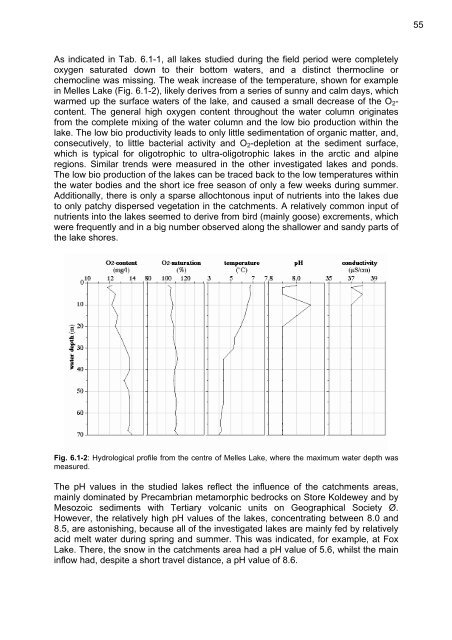the Expedition ARKTIS-XIX/4 of the research vessel POLARSTERN ...
the Expedition ARKTIS-XIX/4 of the research vessel POLARSTERN ...
the Expedition ARKTIS-XIX/4 of the research vessel POLARSTERN ...
Create successful ePaper yourself
Turn your PDF publications into a flip-book with our unique Google optimized e-Paper software.
As indicated in Tab. 6.1-1, all lakes studied during <strong>the</strong> field period were completely<br />
oxygen saturated down to <strong>the</strong>ir bottom waters, and a distinct <strong>the</strong>rmocline or<br />
chemocline was missing. The weak increase <strong>of</strong> <strong>the</strong> temperature, shown for example<br />
in Melles Lake (Fig. 6.1-2), likely derives from a series <strong>of</strong> sunny and calm days, which<br />
warmed up <strong>the</strong> surface waters <strong>of</strong> <strong>the</strong> lake, and caused a small decrease <strong>of</strong> <strong>the</strong> O2content.<br />
The general high oxygen content throughout <strong>the</strong> water column originates<br />
from <strong>the</strong> complete mixing <strong>of</strong> <strong>the</strong> water column and <strong>the</strong> low bio production within <strong>the</strong><br />
lake. The low bio productivity leads to only little sedimentation <strong>of</strong> organic matter, and,<br />
consecutively, to little bacterial activity and O2-depletion at <strong>the</strong> sediment surface,<br />
which is typical for oligotrophic to ultra-oligotrophic lakes in <strong>the</strong> arctic and alpine<br />
regions. Similar trends were measured in <strong>the</strong> o<strong>the</strong>r investigated lakes and ponds.<br />
The low bio production <strong>of</strong> <strong>the</strong> lakes can be traced back to <strong>the</strong> low temperatures within<br />
<strong>the</strong> water bodies and <strong>the</strong> short ice free season <strong>of</strong> only a few weeks during summer.<br />
Additionally, <strong>the</strong>re is only a sparse allochtonous input <strong>of</strong> nutrients into <strong>the</strong> lakes due<br />
to only patchy dispersed vegetation in <strong>the</strong> catchments. A relatively common input <strong>of</strong><br />
nutrients into <strong>the</strong> lakes seemed to derive from bird (mainly goose) excrements, which<br />
were frequently and in a big number observed along <strong>the</strong> shallower and sandy parts <strong>of</strong><br />
<strong>the</strong> lake shores.<br />
Fig. 6.1-2: Hydrological pr<strong>of</strong>ile from <strong>the</strong> centre <strong>of</strong> Melles Lake, where <strong>the</strong> maximum water depth was<br />
measured.<br />
The pH values in <strong>the</strong> studied lakes reflect <strong>the</strong> influence <strong>of</strong> <strong>the</strong> catchments areas,<br />
mainly dominated by Precambrian metamorphic bedrocks on Store Koldewey and by<br />
Mesozoic sediments with Tertiary volcanic units on Geographical Society Ø.<br />
However, <strong>the</strong> relatively high pH values <strong>of</strong> <strong>the</strong> lakes, concentrating between 8.0 and<br />
8.5, are astonishing, because all <strong>of</strong> <strong>the</strong> investigated lakes are mainly fed by relatively<br />
acid melt water during spring and summer. This was indicated, for example, at Fox<br />
Lake. There, <strong>the</strong> snow in <strong>the</strong> catchments area had a pH value <strong>of</strong> 5.6, whilst <strong>the</strong> main<br />
inflow had, despite a short travel distance, a pH value <strong>of</strong> 8.6.<br />
55

















